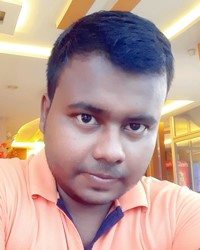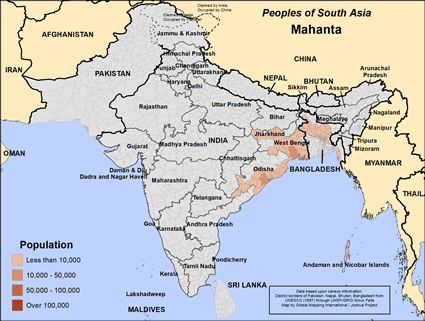Mahanta in Bangladesh

Photo Source:
Anonymous
|

Map Source:
People Group data: Omid. Map geography: UNESCO / GMI. Map Design: Joshua Project.
|
| People Name: | Mahanta |
| Country: | Bangladesh |
| 10/40 Window: | Yes |
| Population: | 1,900 |
| World Population: | 94,900 |
| Primary Language: | Bengali |
| Primary Religion: | Hinduism |
| Christian Adherents: | 0.00 % |
| Evangelicals: | 0.00 % |
| Scripture: | Complete Bible |
| Ministry Resources: | Yes |
| Jesus Film: | Yes |
| Audio Recordings: | Yes |
| People Cluster: | South Asia Hindu - other |
| Affinity Bloc: | South Asian Peoples |
| Progress Level: |
|
Introduction / History
The Mahanta people live in northeast India and Bangladesh. A mahant is a religious leader who is a chief priest or the head of a monastery. He can be the keeper or guardian for a holy site for either Hindus or Sikhs. The Mahanta people are members of the Kshatriya caste, the second highest caste group of Hinduism. The Kshatriya claim to be descendants of rulers, large landowners and military officers.
Where Are they Located?
Most of the Mahanta people live in the Indian states of West Bengal, Odisha or Jharkhand. The Bangladeshi Mahanta live in the states of Chittagong, Dhaka and Rajshahi.
What Are Their Lives Like?
Today there is a great variety in the occupations of the Mahanta. Those who are educated serve as physicians, politicians, government administrators, businesspersons and entertainers. Less educated Mahanta labor in the fields and work in factories. The primary languages of the Mahanta are Odia and Bengali. Educated Mahanta also speak Hindi and English.
The Mahanta marry within their caste. Elders arrange marriages. The bride often goes to live with the groom's family when she reaches puberty. Child marriages are becoming less common than they were in the past. Monogamy, marriage to one spouse, is the rule. Sons inherit property with the eldest son receiving the father's title and home. Caste councils consisting of elders settle legal disputes and promote their interests. Some better-educated Mahanta live in large cities while many others live in rural villages.
The Mahanta are not vegetarians but as Hindus will not eat beef. Rice, wheat, vegetables, fruit and dairy products are their main foods. Social use of alcohol is forbidden by their customs but many Mahanta drink to excess.
What Are Their Beliefs?
The Mahant practice Hinduism, the ancient religion of India. They worship and serve the gods of the Hindu pantheon. They pay particular allegiance to Shiva, Durga, Hanuman and Vishnu. Hindus believe that by performing rituals and good works that they will attain moksha or freedom from the endless cycle of birth, death and rebirth. The Mahant visit Hindu temples and offer prayers, food, flowers, and incense to their gods. There are many forms of Hinduism, each with its own deities and beliefs.
The main yearly holidays of the Mahanta people are Holi, the festival of colors, Diwali, the festival of lights, Navratri, the celebration of autumn, and Rama Navami, Rama's birthday.
What Are Their Needs?
The Mahanta need to hear the life-changing message of Jesus Christ in a way they can understand. Different methods of sharing the gospel will have to be used depending upon the education level of the Mahanta person. Rural Mahanta would benefit by learning new job skills and in applying modern methods of agriculture to their farms.
Prayer Points
Pray for a movement of Mahanta households to study the Bible and accept the blessings of Christ.
Pray for the Mahanta people to understand and embrace Jesus who wants to bless their families and neighborhoods.
Pray for teams of believers to do sustained, focused prayer for the Lord to open the hearts of Mahanta family leaders to experience God's blessing through a movement of family-based discovery Bible studies.
Pray for a movement of Jesus to heal and strengthen Mahanta communities.